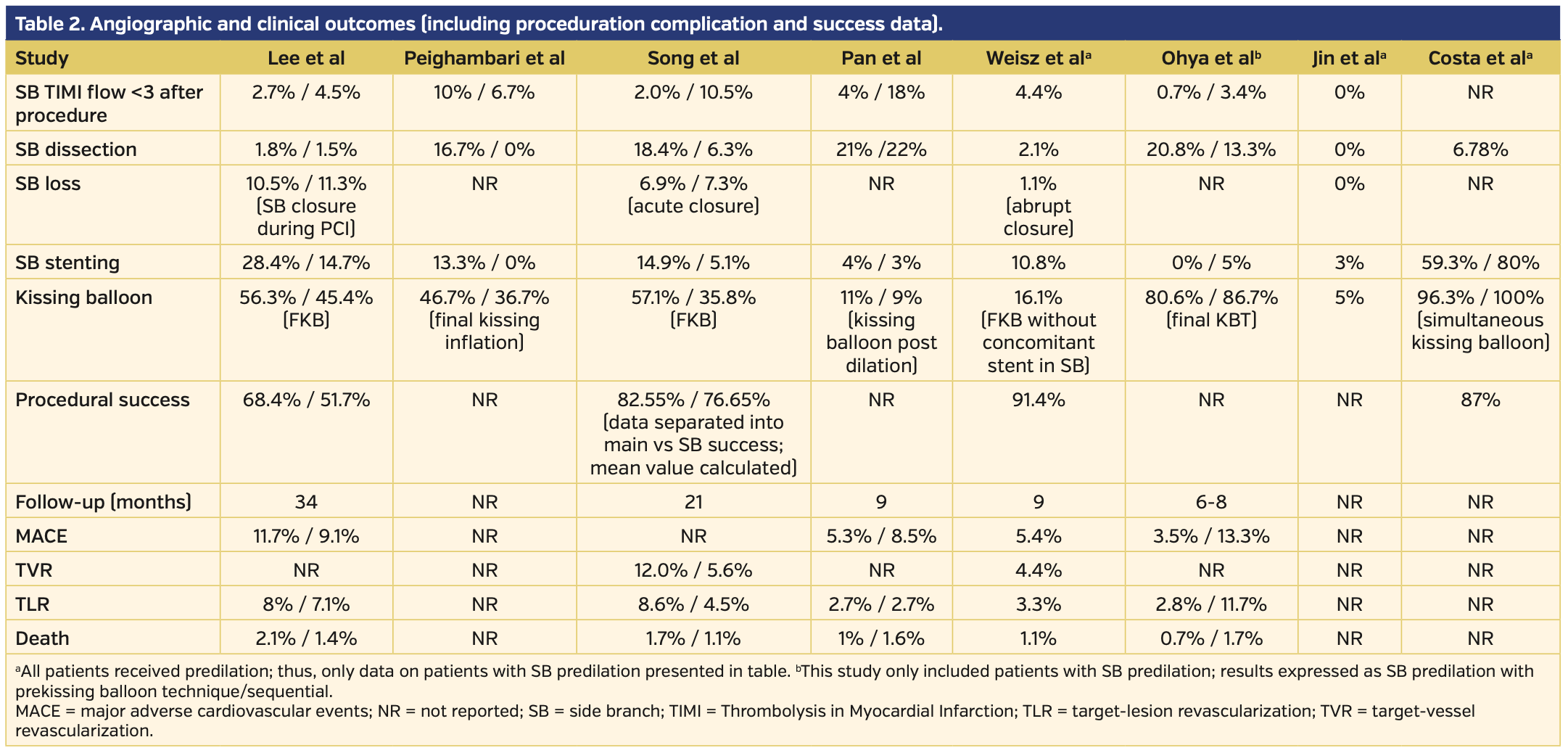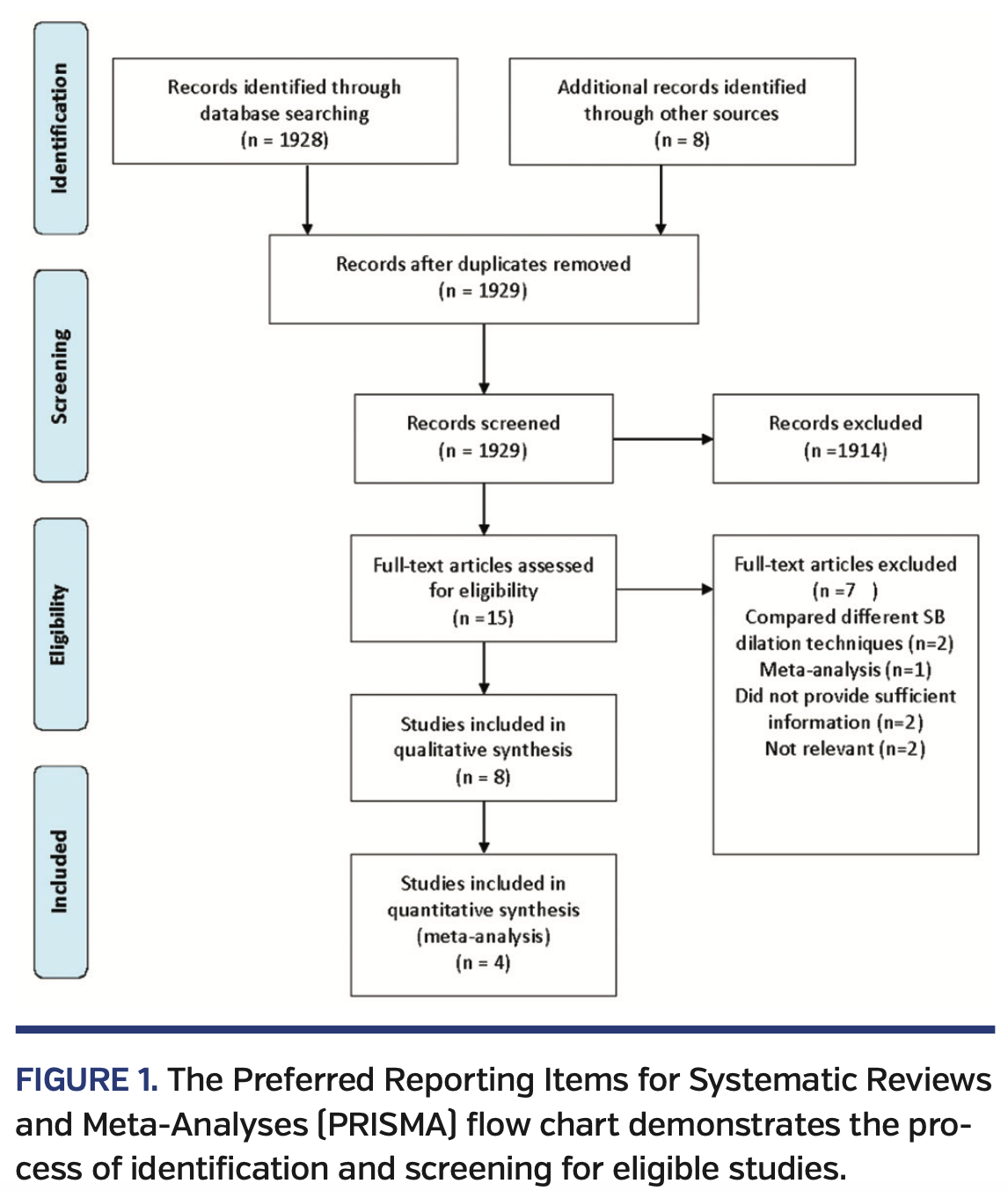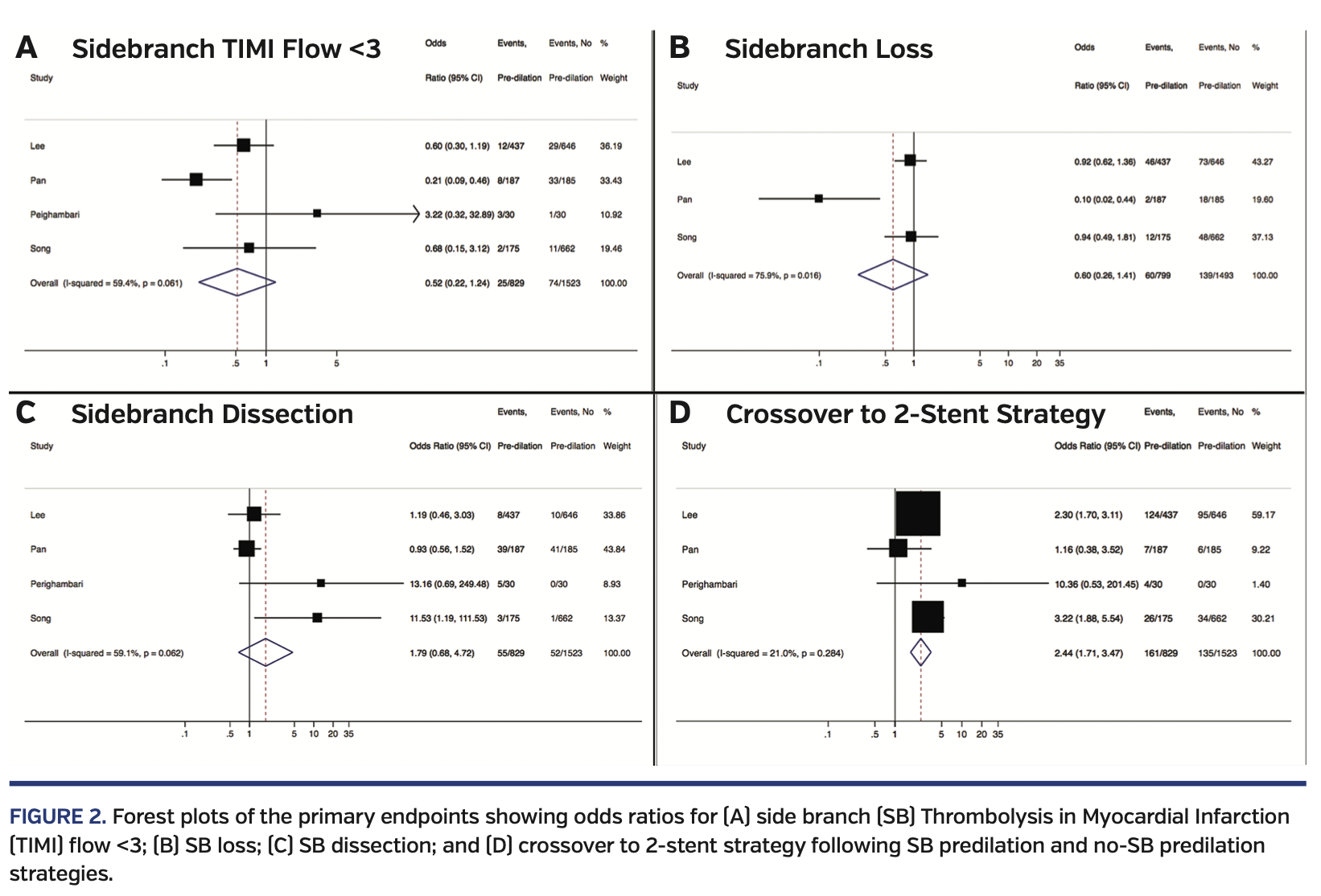ADVERTISEMENT
Impact of Side-Branch Predilation on Angiographic Outcomes in Non-Left Main Coronary Bifurcation Lesions
Abstract: Background. Despite the high prevalence of coronary bifurcation lesions in routine interventional cardiology practice, the best strategy for managing this challenging lesion subset remains debatable. Due to potential for complications, the routine practice of side-branch (SB) predilation is controversial. Methods. An electronic search was performed of online databases up until April 2018 for studies reporting periprocedural angiographic outcomes comparing provisional main-branch stenting with and without SB predilation. Random-effects model odds ratios (ORs) were calculated. Results. Eight studies were selected for a qualitative review, with 47.3% (1367/2890) of included subjects having angiographic outcomes following SB predilation reported. Of these, four studies included details of periangiographic outcomes comparing two groups. Bifurcation lesions stented without SB predilation demonstrated lower odds of requiring further SB intervention compared with lesions receiving upfront SB predilation (OR, 2.44; 95% confidence interval [CI], 1.71-3.47; I2=21%; P<.001). No difference was demonstrated regarding final SB TIMI flow <3, SB dissection, or intraprocedural SB occlusion. Although the odds of performing final kissing-balloon inflation were in favor of the group without SB predilation (OR, 1.62; 95% CI, 1.11-2.37; I2=61%; P=.01), there was no statistical difference in long-term major cardiovascular outcome (MACE) between the two groups (risk ratio, 1.29; 95% CI, 0.94-1.75; I2=11%; P=.33). Conclusion. SB predilation during coronary bifurcation percutaneous coronary intervention did not alter overall procedural angiographic outcomes. However, SB predilation is associated with increased SB intervention, including increased requirement for SB stenting, without demonstrable long-term MACE benefit, compared with a standard strategy without SB predilation.
Key words: bifurcation, left main interventions, percutaneous coronary intervention
Bifurcation stenoses are common coronary artery lesions, comprising approximately 20% of percutaneous coronary intervention (PCI) procedures.1 Despite substantial advances in device technology, bifurcation lesions (BFLs) remain one of the most challenging procedural subsets in PCI practice. Although a large body of published evidence from previous clinical trials recommends a provisional main-branch (MB) stenting approach as the preferred strategy in most BFLs, the optimal management of side-branch (SB) disease remains controversial.2 This issue is particularly important because SB lesions may have prognostic value, as iatrogenic occlusion of sizable-caliber coronary SB vessels has previously been associated with adverse clinical outcomes.3 It is well documented that BFL-PCI is associated with increased periprocedural and longer-term complications — including increased restenosis and stent thrombosis — when compared with non-BFL PCI.4,5
Data are lacking regarding the ideal technique for management of SB disease in BFLs. Previous clinical trials demonstrated a lack of proven benefit from routine systematic two-stent PCI vs provisional stenting (PS).6 Notably, a recent meta-analysis of 3265 subjects with a mean follow-up of 4.7 years reported that PS was associated with a reduction in all-cause mortality.7 In light of such data, interventionalists treating more complex coronary lesions may find such data unhelpful, as certain complex lesion subsets may appear angiographically inappropriate for a PS approach. As such, numerous trials have proposed various two-stent strategies to deal with more complex bifurcation disease.8-10 Despite this, two-stent PCI is associated with extended procedure times, greater contrast volumes, and longer fluoroscopy times, all of which collectively increase the risk of further adverse peri- and postprocedural events.11
Further optimization of BFL-PCI outcomes in order to improve long-term prognosis remains an ongoing quest. Recent studies have evaluated outcomes relating to different procedural strategies during BFL stenting.12 Procedural success in treating such lesions has been demonstrated to be dependent on several factors, including the type of stent utilized (bare-metal vs drug-eluting vs biodegradable scaffold), the anatomical characteristics of the SB (including vessel diameter and angulation from the MB), atheroma distribution and composition, and the techniques utilized by the interventionalist.13-15
The dominant procedural concern with PS is the risk of compromised blood flow in a moderate- to large-caliber SB. Such an outcome is difficult to predict due to the complex geometry of SBs, depending on plaque distribution across the BFL.16 The potential pathophysiological mechanisms of SB compromise after main-vessel stenting include plaque shift, vessel dissection, ostial SB spasm, plaque embolization, and compromise of the SB by stent strut thrombosis.17
In order to improve outcomes, MB preparation and predilation according to the preference of the operator is generally recommended. Where provisional MB stenting is procedurally appropriate, it remains unclear as to whether prestent dilation of ostial SB lesions offers a procedural advantage, or whether such a strategy actually increases procedural risk without clinical advantage. Although primarily intended to improve SB patency post MB-PCI, SB predilation may have unintended consequences, including ostial dissection and SB compromise, necessitating unplanned two-stent PCI. As such, systematic SB predilation prior to MB-PCI remains a topic of considerable controversy within the interventional community. As left main coronary BFLs appear to have a unique anatomical value and prognostic relevance, the objective of this systematic review and meta-analysis was to evaluate the effect of SB predilation on immediate angiographic outcomes and longer-term major adverse cardiovascular events in non-left main coronary bifurcation disease.
Methods
Data sources and literature search. This review was conducted according to the Preferred Reporting Items for Systematic Reviews and Meta-Analyses (PRISMA) statement.18 To identify suitable publications, comprehensive searches were conducted in MEDLINE, EMBASE, and the Cochrane Library, along with trial registries and abstracts from major scientific meetings. Searches were performed employing Medical Subject Heading (MeSH) and keywords including, but not limited to: “bifurcation lesion,” “coronary artery disease,” and “side branch predilation/predilation.” Our search was restricted to studies published in the English language. An example search strategy for EMBASE is provided in Table 3. The study protocol was prospectively registered with PROSPERO (CRD42018094304).
Inclusion and exclusion criteria. Inclusion criteria for studies were as follows: (1) prospective trials and/or registry studies; and (2) studies reporting and/or comparing angiographic and clinical outcomes of SB predilation in a coronary BFL. Studies were excluded if SB predilation or intervention was performed via non-routine strategies, such as jailed-balloon technique, modified jailed-balloon techniques, and similar unconventional procedural strategies. In the event of multiple publications reporting results from the same institution on the same patient cohort, only the most recent paper with the largest sample size and/or follow-up period was included for analysis.
Study endpoints. Periprocedure efficacy endpoints were as follows: Thrombolysis in Myocardial Infarction (TIMI) flow grade <3; SB dissection; SB occlusion; and crossover rate to two-stent PCI. Safety and long-term outcomes were as follows: probable or definite major adverse cardiovascular events; all-cause mortality; target-vessel revascularization (TVR); and target-lesion revascularization (TLR).
Data items and collection process. Prespecified efficacy and safety endpoints were determined prior to the literature search. Two authors (SM and MI) independently conducted the search and data extraction for baseline patient demographics and clinical outcomes. Extracted data were verified by the senior author (BD) and any discrepancies were resolved by consensus agreement.
Statistical analysis. The systematic review and meta-analysis were performed using Review Manager (RevMan), version 5.3 (Cochrane Collaboration) and Stata 14/MP (StataCorp). Outcomes were analyzed using a Peto random-effect models and summary estimates reported as pooled odds ratios (ORs) with 95% confidence intervals (CIs) and risk ratio (RR) with 95% CI. Heterogeneity was assessed for all endpoints with the I2 statistic. Heterogeneity was regarded as low, moderate, or high based on an I2 value of 25%, 50%, and 75%, respectively.19 For all analyses, a two-sided P-value of <.05 was considered significant.
Results
As demonstrated in Figure 1, the search originally yielded 1928 articles. Eight studies were selected for qualitative review20-27 and four of these were further analyzed for study endpoints.20-23 A total of 1367 patients (47.3%) out of 2860 study subjects had SB predilation prior to MB stenting with a mean follow-up duration of 11 months. The study characteristics are summarized in Table 1.
Primary endpoint. Subjects treated without SB predilation had lower odds of requirement for further coronary intervention and SB stenting, compared with the SB-predilation group (OR, 2.44; 95% CI, 1.71-3.47; I2=21%; P<.001). No difference was demonstrated between the groups with MB stenting with or without SB predilation regarding periprocedural SB TIMI flow<3, SB dissection, or SB occlusion (Figure 2).
Secondary endpoints. The odds of performing final kissing-balloon inflation were in favor of MB stenting without SB predilation (OR, 1.62; 95% CI, 1.11-2.37; I2=61%; P=.01). There was no statistical difference in rates of TVR/TLR (RR, 1.43; 95% CI, 0.87-2.37; I2=51%; P=.13) or long-term major adverse cardiovascular outcomes (RR, 1.29; 95% CI, 0.94-1.75; I2=11%; P=.33) between the two groups, even allowing for increased use of two-stent PCI in the SB predilation group.
Efficacy outcomes. Four studies reported the primary endpoint of the immediate angiographic outcome between MB stenting with SB predilation and without SB predilation. In patients receiving SB predilation, a total of 161 patients (19.4%) crossed over to two-stent PCI compared with 135 patients (8.8%) in the group that had conventional management without SB predilation. However, no difference was exhibited regarding intraprocedural SB TIMI flow <3 (OR, 0.52; 95% CI, 0.22-1.24; I2=59%; P=.06), SB dissection (OR, 1.79; 95% CI, 0.68-4.72; I2=59%; P=.06) or SB occlusion (OR, 0.60; 95% CI, 0.26-1.41; I2=76%; P=.01) between subjects undergoing MB-PCI without SB predilation vs subjects receiving SB predilation prior to MB-PCI (Figure 2). Similarly, pooled analysis demonstrated no significant difference in long-term rates of TVR/TLR and major adverse cardiovascular events at reported follow-up durations ranging between 30 days and 9 months in the relevant studies.
Publication bias. Given that there were less than 10 studies in the analysis, the authors abandoned the planned evaluation of publication bias.
Discussion
To the best of our knowledge, this is the first systematic review and meta-analysis evaluating outcomes for BFL-PCI, comparing over 2500 subjects receiving SB predilation prior to MB-PS vs subjects stented without SB predilation (Figure 2). Most notably, MB-PS without SB predilation was associated with reduced procedural complexity, with SB predilation associated with a significant increase in crossover from an upfront PS strategy to unplanned two-stent PCI. Although there were no significant differences between the groups in terms of immediate postprocedural angiographic outcomes, PS without SB predilation was associated with increased performance of final kissing-balloon inflation following MB stenting. Importantly, this meta-analysis demonstrates a failure of improvement in major adverse cardiovascular events between MB-PCI with vs without SB predilation at maximum follow-up of 9 months. This trend extends to overall mortality, myocardial infarction, TLR, and TVR, with I2 statistics of 11% reflecting minimal heterogeneity.
These results reinforce current literature promoting BFL-PCI without routine SB predilation, except in cases involving sizable SB diameter, heavy calcification, severe ostial SB stenosis, or the presence of difficult access or “threatened” SB ostial anatomy where predilation with a small-sized balloon might be beneficial.23 Such recommendations arose due to concerns regarding the potential for adverse events associated with SB predilation technique — including SB dissection, increased risk of requirement for SB stenting, and higher risk of SB restenosis.23 Notwithstanding the significantly increased crossover from PS to more complex two-stent bifurcation PCI following SB predilation in our analysis, this approach failed to improve patient outcomes.
Overall, the available data suggest that routine SB predilation prior to PS is not an overly beneficial treatment option and may not improve immediate angiographic and long-term major adverse cardiovascular event outcomes compared with PS without SB predilation. Higher rates of bail-out two-stent PCI following SB predilation may also be linked with increasing procedural time, greater procedural complexity, and higher contrast dose, without improvements in measurable angiographic or clinical outcomes. Such results strongly support current recommendations favoring simple PS of bifurcation lesions in the majority of cases. Longer-term follow-up of subjects in PS clinical studies may provide further insights into hazards associated with simple and more complex PS strategies. Future developments in novel techniques for PS, in conjunction with advancement of stent design, may further impact patient outcomes.
Study limitations. The results of this meta-analysis must be interpreted in view of the inherent limitations associated with statistical comparisons of heterogenous clinical studies. Subjective reporting of angiographic outcomes such as TIMI flow, and discrepancies in the description of major adverse cardiovascular events between studies may also have impacted our results. Finally, heterogeneity existed among the studies in the time interval for reporting clinical outcome, which may have impacted the complication rates.
Conclusions
Routine SB predilation prior to PS in the management of non-left main coronary bifurcation lesions cannot be recommended, as it appears not to significantly improve overall angiographic outcomes. Routine SB predilation is, however, associated with greater incidence of intraprocedural SB compromise necessitating increased utilization of two-stent strategies, without long-term major adverse cardiovascular event rate benefit when compared with a BFL-PCI strategy without routine SB predilation.
From the 1Monash Cardiovascular Research Centre, Monash Heart, Monash Health, Monash University, Melbourne, Australia; and 2Monash University, Monash School of Medicine, Melbourne, Australia.
Disclosure: The authors have completed and returned the ICMJE Form for Disclosure of Potential Conflicts of Interest. Dr Mizraee reports consultant income from Amgen, outside the submitted work. The remaining authors report no conflicts of interest regarding the content herein.
Manuscript submitted June 19, 2019, and accepted June 28, 2019.
Address for correspondence: Dr B.K. Dundon, Monash Cardiovascular Research Centre, MonashHeart, Monash Health, Melbourne, Australia, Monash University – 246 Clayton Road, Clayton, VIC 3168 Australia. Email: benjamin.dundon@monashhealth.org
- Lee SH, Song YB, Lee JM, et al. Effect of side branch predilation in coronary bifurcation stenting with the provisional approach — results from the COBIS (Coronary Bifurcation Stenting) II registry. Circ J. 2018;82:1293-1301.
- Sawaya FJ, Lefevre T, Chevalier B, et al. Contemporary approach to coronary bifurcation lesion treatment. JACC Cardiovasc Interv. 2016;9:1861-1878.
- Hahn JY, Chun WJ, Kim JH, et al. Predictors and outcomes of side branch occlusion after main vessel stenting in coronary bifurcation lesions: results from the COBIS II registry (Coronary BIfurcation Stenting). J Am Coll Cardiol. 2013;62:1654-1659.
- Hildick-Smith D, de Belder AJ, Cooter N, et al. Randomized trial of simple versus complex drug-eluting stenting for bifurcation lesions. The British bifurcation coronary study: old, new, and evolving strategies. Circulation. 2010;121:1235-1243.
- Hoye A, Iakovou I, Ge L, et al. Long-term outcomes after stenting of bifurcation lesions with the “crush” technique: predictors of an adverse outcome. J Am Coll Cardiol. 2006;47:1949-1958.
- Steigen TK, Maeng M, Wiseth R, et al. Randomized study on simple versus complex stenting of coronary artery bifurcation lesions: the Nordic bifurcation study. Circulation. 2006;114:1955-1961.
- Ford TJ, McCartney P, Corcoran D, et al. Single- versus two-stent strategies for coronary bifurcation lesions: a systematic review and meta-analysis of randomized trials with long-term follow-up. J Am Heart Assoc. 2018;7:e008730.
- Chen S, Zhang J, Ye F, et al. Study comparing the double kissing (DK) crush with classical crush for the treatment of coronary bifurcation lesions: the DKCRUSH-1 bifurcation study with drug-eluting stents. Eur J Clin Invest. 2008;38:361-371.
- Colombo A, Bramucci E, Saccà S, et al. Randomized study of the crush technique versus provisional side-branch stenting in true coronary bifurcations: the CACTUS (Coronary Bifurcations: Application of the Crushing Technique Using Sirolimus-Eluting Stents) study. Circulation. 2009;119:71-78.
- Ferenc M, Gick M, Kienzle R-P, et al. Randomized trial on routine vs provisional T-stenting in the treatment of de novo coronary bifurcation lesions. Eur Heart J. 2008;29:2859-2867.
- Iakovou I, Ge L, Colombo A. Contemporary stent treatment of coronary bifurcations. J Am Coll Cardiol. 2005;46:1446-1455.
- Nairooz R, Saad M, Elgendy IY, et al. Long-term outcomes of provisional stenting compared with a two-stent strategy for bifurcation lesions: a meta-analysis of randomised trials. Heart. 2017;103:1427.
- Zamani P, Kinlay S. Long-term risk of clinical events from stenting side branches of coronary bifurcation lesions with drug-eluting and bare-metal stents: an observational meta-analysis. Catheter Cardiovasc Interv. 2011;77:202-212.
- Genereux P, Kumsars I, Schneider JE, et al. Dedicated bifurcation stent for the treatment of bifurcation lesions involving large side branches: outcomes from the Tryton confirmatory study. JACC Cardiovasc Interv. 2016;9:1338-1346.
- Zimarino M, Corazzini A, Ricci F, Di Nicola M, De Caterina R. Late thrombosis after double versus single drug-eluting stent in the treatment of coronary bifurcations: a meta-analysis of randomized and observational studies. JACC Cardiovasc Interv. 2013;6:687-695.
- Dobrin V, Robert G. Clinical verification of a theory for predicting side branch stenosis after main vessel stenting in coronary bifurcation lesions. J Interv Cardiol. 2008;21:493-503.
- Furukawa E, Hibi K, Kosuge M, et al. Intravascular ultrasound predictors of side branch occlusion in bifurcation lesions after percutaneous coronary intervention. Circ J. 2005;69:325-330.
- Moher D, Liberati A, Tetzlaff J, Altman DG. Preferred reporting items for systematic reviews and meta-analyses: the PRISMA statement. PLoS Med. 2009;6:e1000097.
- Higgins JP, Thompson SG, Deeks JJ, Altman DG. Measuring inconsistency in meta-analyses. BMJ. 2003;327:557-560.
- Song PS, Song YB, Yang JH, et al. The impact of side branch predilation on procedural and long-term clinical outcomes in coronary bifurcation lesions treated by the provisional approach. Rev Esp Cardiol (Engl Ed). 2014;67:804-812.
- Peighambari M, Sanati H, Hadjikarimi M, et al. The effects of side branch predilation during provisional stenting of coronary bifurcation lesions: a double-blind randomized controlled trial. Res Cardiovasc Med. 2016;5:e31378.
- Lee SH, Pi S, Kwon W, Song YB. TCT-798 The effect of side branch predilation in coronary bifurcation stenting with the provisional approach results from the COBIS (COronary BIfurcation Stenting) II registry. J Am Coll Cardiol. 2017;70:B324.
- Pan M, Medina A, Romero M, et al. Assessment of side branch predilation before a provisional T-stent strategy for bifurcation lesions. A randomized trial. Am Heart J. 2014;168:374-380.
- Weisz G, Metzger DC, Liberman HA, et al. A provisional strategy for treating true bifurcation lesions employing a scoring balloon for the side branch: final results of the AGILITY trial. Catheter Cardiovasc Interv. 2013;82:352-359.
- Ohya H, Kyo E, Tsuji T, Watanabe S, Katoh O. Impact on clinical outcomes of predilatation using the kissing-balloon technique for crossover stenting in true coronary bifurcation lesions. J Invasive Cardiol. 2013;25:512-518.
- Jin Z, Li L, Wang M, Zhang S, Chen Z, Shen Z. Innovative provisional stenting approach to treat coronary bifurcation lesions: balloon-stent kissing technique. J Invasive Cardiol. 2013;25:600-604.
- Costa RA, Feres F, Staico R, et al. Impact of side branch predilation on percutaneous coronary intervention in complex coronary bifurcation lesions. Rev Bras Cardiol Invasiva. 2012;20:125-132.
















